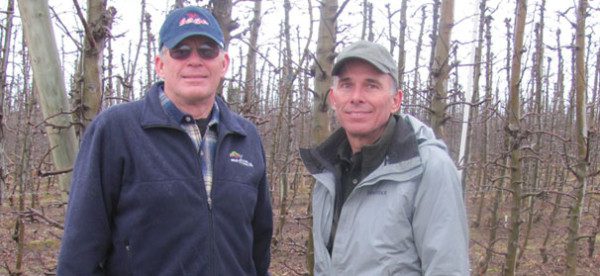

Jul 28, 2011Experimenting with high-density blocks
In March, an International Fruit Tree Association tour visited C&M Orchards near Prosser, Wash., where owners Craig and Mike O’Brien showed their visitors a 52-acre block of high-density apples they planted in 2000.
The apples are Buckeye Galas, grown in a super spindle system on dwarfing rootstock (M.9337). The rows are 10 feet apart, the trees 2 feet apart within each row. The brothers decided to plant that way after observing similar systems in other orchards in Washington state and British Columbia. Their objective was to bring the block into rapid production, grow more target fruit and achieve a more even distribution of light. It seems to have worked. The block is getting high yields (it started yielding fruit in 2002) and evenly colored fruit with good size, Craig said.
The O’Briens are planting more and more Galas on super spindle, which has proven to be a successful system with that variety. Fujis haven’t been as cooperative on super spindle, so they’ve been planting them on V-trellis (they’re also experimenting with some Galas on V-trellis), Craig said.
When Craig and Mike took over the family orchard three decades ago, Red Delicious trees were planted 10 feet apart, in rows 20 feet apart. Thirty years later, their latest plantings are even denser than the Gala block they showed the IFTA group. They recently planted another block of Galas on super spindle, with rows 9 feet apart and trees 20 inches apart. Some of their Fujis on V-trellis are 18 inches and 12 feet apart, respectively, Craig said.
“One of these days, we’ll find out how close is too close,” he said. “I think we’re approaching that.”
Apogee, a growth regulator, is a great tool to use in these high-density systems, which tend to cause excessive growth, he said.
History
C&M Orchards goes back to 1947, when George O’Brien first broke ground on about 220 acres of sagebrush in the Roza irrigation district. Initially, George grew crops like potatoes, wheat and mint, but eventually added peaches and apples to the mix. His two sons took over the family business in the 1970s. They farm roughly 400 acres today – about 250 acres of apples, 80 acres of juice and wine grapes and 45 acres of sweet cherries, Craig said.
Most of their apple acres are planted in Gala and Fuji, followed by Braeburn, Red Delicious and Granny Smith. The majority of the apples end up on the shelves of major grocery chains, he said.
About 15 years ago, they got into organic growing – seeking to diversify and spread their risk. They have about 65 acres of certified organic apples today, and 30 acres of organic cherries, he said.
The lessons they’ve learned from organic growing – about the life cycles and interactions of beneficial and target insects, about soil and nutrition – have helped them with their conventional crops as well. They’re doing a better job monitoring pests and diseases such as scab and fire blight, Craig said.
The brothers have no plans to expand their organic acreage at this time. It’s tough to maintain an organic system and achieve consistent yields, especially in apples. And though the organic market has been growing overall, supply and demand tend to seesaw from year to year. Still, the organic market is here to stay, Craig said.
By Matt Milkovich, Managing Editor














